Lead-acid batteries failing to meet their design life length can be attributed to several factors, both inherent to the battery technology and influenced by external conditions.
- Operating Conditions: Lead-acid batteries are sensitive to operating conditions such as temperature, depth of discharge, and charging/discharging rates. Exposure to extreme temperatures, frequent deep discharges, or overcharging can accelerate battery degradation and reduce lifespan.
- Improper Maintenance: Proper maintenance is crucial for maximizing the lifespan of lead-acid batteries. Neglecting tasks such as checking electrolyte levels, maintaining proper charging voltage, and ensuring clean terminals can lead to premature failure.
- Sulfation: Sulfation occurs when lead sulfate crystals accumulate on the battery plates, reducing the effective surface area available for electrochemical reactions. This can happen if batteries are left in a discharged state for extended periods or if they are not properly recharged.
- Grid Corrosion: Corrosion of the lead plates’ grid structure can occur due to factors such as exposure to high temperatures, overcharging, or impurities in the electrolyte. Grid corrosion weakens the structural integrity of the plates and can lead to premature failure.
- Manufacturing Defects: In rare cases, lead-acid batteries may have manufacturing defects that compromise their performance or lifespan. These defects can include issues such as uneven plate thickness, poor welds, or impurities in the materials used.
- Vibration and Mechanical Stress: Lead-acid batteries can be susceptible to damage from vibration and mechanical stress, particularly in mobile or industrial applications. Physical damage to the battery casing or internal components can shorten lifespan.
- Overdischarge: Allowing lead-acid batteries to become deeply discharged can cause irreversible damage to the plates and lead to loss of capacity. Protective measures such as low-voltage disconnects or battery management systems can help prevent overdischarge.
- Chemical Impurities: Contaminants or impurities in the electrolyte can accelerate battery degradation and reduce lifespan. Regular maintenance and proper electrolyte replenishment using distilled water can help mitigate this risk.
- Inadequate Sizing or Design: Using batteries that are undersized for the intended application or selecting a design that does not account for specific operational requirements can lead to premature failure due to excessive stress or inadequate performance.
- Cycle Life Degradation: Over time, the ability of lead-acid batteries to withstand charge-discharge cycles may degrade due to factors such as active material shedding, electrolyte loss, or changes in internal resistance.
Addressing these factors through proper maintenance, appropriate operational practices, and careful selection of batteries can help extend the lifespan of lead-acid batteries and improve their reliability. Additionally, advancements in battery technology and materials continue to drive improvements in performance and longevity.


